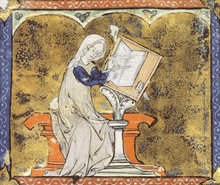Synopsis
Bisclavret, a baron in Brittany who is well loved by the king, vanishes every week for three full days. No one in his household, not even his wife, knows where he goes. His wife finally begs him to tell her his secret and he explains that he is a werewolf. He also says that while in werewolf form he needs to hide his clothing in a safe place so he can return to human form. The baron's wife is so shocked by this news that she tries to think of ways she can escape her husband. She does not want to "lie beside him any more". [5] She conspires with a knight who has loved her for a long time. The following week, the baron's wife sends the knight to steal her husband's clothing. When her husband fails to return, she marries the knight. The baron's people search for him but finally relent, feeling that their absentee ruler has left for good.
A year later, the king goes hunting and his dogs corner Bisclavret, now fixed in wolf form. As soon as he sees him, Bisclavret runs to the king to beg for mercy by taking the king's stirrup and kissing his foot and leg. This behavior so astounds the king that he has his companions drive back the dogs and everyone marvels at the wolf's nobility and gentleness. The king takes Bisclavret, still in wolf form, back to the castle to live with him.
The knight who had married Bisclavret's wife is invited to the castle for a celebration along with all the other barons. As soon as he sees him, Bisclavret attacks the man. The king calls to Bisclavret and threatens him with his staff. Because he never acted so violently before, everybody in the court thinks the knight must somehow have wronged the wolf. Soon after, the king visits the area where the baron used to live and brings the werewolf along with him. Bisclavret's wife learns of the king's arrival and takes many gifts for him. When he sees his former wife, nobody can restrain Bisclavret. He attacks her, tearing off her nose.
A wise man points out that the wolf had never acted so before and that this woman was the wife of the knight whom Bisclavret had recently attacked. The wise man also tells the king that this woman is the former wife of the missing baron. The king has the wife questioned under torture. She confesses all and yields up the stolen clothing. The king's men put the clothing before the wolf, but he ignores it. The wise man advises them to take the wolf and the clothing into a bedchamber and let Bisclavret change in privacy. Bisclavret does so, and when he again sees him, the king runs to his beloved baron and embraces him, giving him many kisses. The king restores Bisclavret's lands to him and exiles the baroness and her knight. Many of the wife's female progeny were afterwards born without noses and all of her children were "quite recognizable in face and appearance." [6]

In folklore, a werewolf, or occasionally lycanthrope is an individual who can shape-shift into a wolf, either purposely or after being placed under a curse or affliction, with the transformations occurring on the night of a full moon. Early sources for belief in this ability or affliction, called lycanthropy, are Petronius (27–66) and Gervase of Tilbury (1150–1228).

Marie de France was a poet, possibly born in what is now France, who lived in England during the late 12th century. She lived and wrote at an unknown court, but she and her work were almost certainly known at the royal court of King Henry II of England. Virtually nothing is known of her life; both her given name and its geographical specification come from manuscripts containing her works. However, one written description of her work and popularity from her own era still exists. She is considered by scholars to be the first woman known to write francophone verse.

Sir Orfeo is an anonymous Middle English Breton lai dating from the late 13th or early 14th century. It retells the story of Orpheus as a king who rescues his wife from the fairy king. The folk song Orfeo is based on this poem.
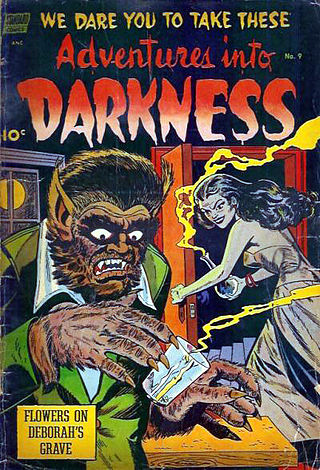
Werewolf fiction denotes the portrayal of werewolves and other shapeshifting therianthropes, in the media of literature, drama, film, games and music. Werewolf literature includes folklore, legend, saga, fairy tales, Gothic and horror fiction, fantasy fiction and poetry. Such stories may be supernatural, symbolic or allegorical. A classic cinematic example of the theme is The Wolf Man (1941) which in later films joins with the Frankenstein Monster and Count Dracula as one of the three famous icons of modern day horror. However, werewolf fiction is an exceptionally diverse genre, with ancient folkloric roots and manifold modern re-interpretations.
The lais of Marie de France are a series of twelve short narrative Breton lais by the poet Marie de France. They are written in Anglo-Norman and were probably composed in the late 12th century, most likely between 1155-1170. The short, narrative poems generally focus on glorifying the concept of courtly love by the adventures of their main characters. Marie's lais are thought to form the basis for what would eventually become the genre known as the Breton lais. Despite her stature in Anglo-Norman literature and medieval French literature generally, little is known of Marie herself, but it is thought that she was born in France and wrote in England.
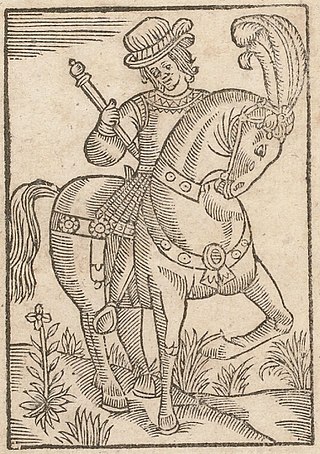
Guillaume de Palerme is a French romance poem, later translated into English where it is also known as William and the Werewolf. The French verse romance was composed c. 1200, commissioned by Countess Yolande. The prose version of the French romance, printed by N Bonfons, passed through several editions.

Mark of Cornwall was a sixth-century King of Kernow (Cornwall), possibly identical with King Conomor. He is best known for his appearance in Arthurian legend as the uncle of Tristan and the husband of Iseult who engages with Tristan in a secret liaison, giving Mark the epithet "Cuckold King".
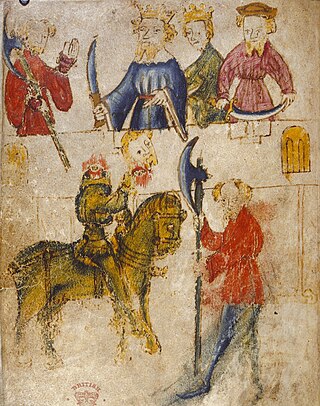
The Green Knight is a heroic character of the Matter of Britain, originating in the 14th-century poem Sir Gawain and the Green Knight and the related medieval work The Greene Knight. His true name is revealed to be Bertilak de Hautdesert in Sir Gawain, while The Greene Knight names him "Bredbeddle". The Green Knight later features as one of Arthur's greatest champions in the fragmentary ballad "King Arthur and King Cornwall", again with the name "Bredbeddle".
The mythologies in present-day France encompass the mythology of the Gauls, Franks, Normans, Bretons, and other peoples living in France, those ancient stories about divine or heroic beings that these particular cultures believed to be true and that often use supernatural events or characters to explain the nature of the universe and humanity. French myth has been primarily influenced by the myths and legends of the Gauls and the Bretons as they migrated to the French region from modern day England and Ireland. Other smaller influences on the development of French mythology came from the Franks.
Sir Launfal is a 1045-line Middle English romance or Breton lay written by Thomas Chestre dating from the late 14th century. It is based primarily on the 538-line Middle English poem Sir Landevale, which in turn was based on Marie de France's lai Lanval, written in a form of French understood in the courts of both England and France in the 12th century. Sir Launfal retains the basic story told by Marie and retold in Sir Landevale, augmented with material from an Old French lai Graelent and a lost romance that possibly featured a giant named Sir Valentyne. This is in line with Thomas Chestre's eclectic way of creating his poetry.
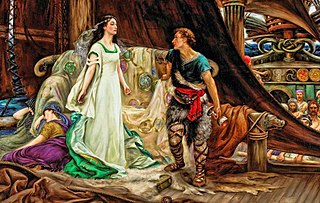
Tristan and Iseult, also known as Tristan and Isolde and other names, is a medieval chivalric romance told in numerous variations since the 12th century. Based on a Celtic legend and possibly other sources, the tale is a tragedy about the illicit love between the Cornish knight Tristan and the Irish princess Iseult. It depicts Tristan's mission to escort Iseult from Ireland to marry his uncle, King Mark of Cornwall. On the journey, Tristan and Iseult ingest a love potion, instigating a forbidden love affair between them.
Lanval is one of the Lais of Marie de France. Written in Anglo-Norman, it tells the story of Lanval, a knight at King Arthur's court, who is overlooked by the king, wooed by a fairy lady, given all manner of gifts by her, and subsequently refuses the advances of Queen Guinevere. The plot is complicated by Lanval's promise not to reveal the identity of his mistress, which he breaks when Guinevere accuses him of having "no desire for women". Before Arthur, Guinevere accuses Lanval of shaming her, and Arthur, in an extended judicial scene, demands that he reveal his mistress. Despite the broken promise, the fairy lover eventually appears to justify Lanval, and to take him with her to Avalon. The tale was popular, and was adapted into English as Sir Landevale, Sir Launfal, and Sir Lambewell.
"Le Fresne" is one of the Lais of Marie de France. It was likely written in the late 12th century. Marie claims it to be a Breton lai, an example of Anglo-Norman literature.
"Eliduc" is a Breton lai by the medieval poet Marie de France. The twelfth and last poem in the collection known as The Lais of Marie de France, it appears in the manuscript Harley 978 at the British Library. Like the other poems in this collection, "Eliduc" is written in the Anglo-Norman dialect of Old French, in couplets of eight syllables in length. At 1184 lines, it is the longest of the lais attributed to Marie de France. The text of the lai notes that its correct title should be Guildeluec and Guilliadon, but the name Eliduc has stuck.
Nabaret is a short, humorous Breton lai that tells the story of a knight and his vain and prideful wife. With only 48 verses, Nabaret is the shortest of the anonymous lais.
Tyolet is an anonymous Breton lai that takes place in the realm of King Arthur. It tells the tale of a naïve young knight who wins the hand of a maiden after a magical adventure.
Melion is an anonymous Breton lai that tells the story of a knight who transforms into a werewolf for the love of his wife who betrays him.
Sir Tryamour is a Middle English romance dated to the late fourteenth century. The source is unknown and, like almost all of the Middle English romances to have survived, its author is anonymous. The 1,719-line poem is written in irregular tail rhyme stanzas composed in the Northeast Midlands dialect. There are textual ambiguities and obscurities that suggest corruption or "loose transmission." Consequently, interpretations, glosses and notes vary between editions, sometimes substantially.

Graelent is an Old French Breton lai, named after its protagonist. It is one of the so-called anonymous lais.
Tiódels saga is an Old Icelandic chivalric saga, based on the Old Norwegian translation, Bisclaretz ljóð, of Marie de France's Breton lai Bisclavret.
